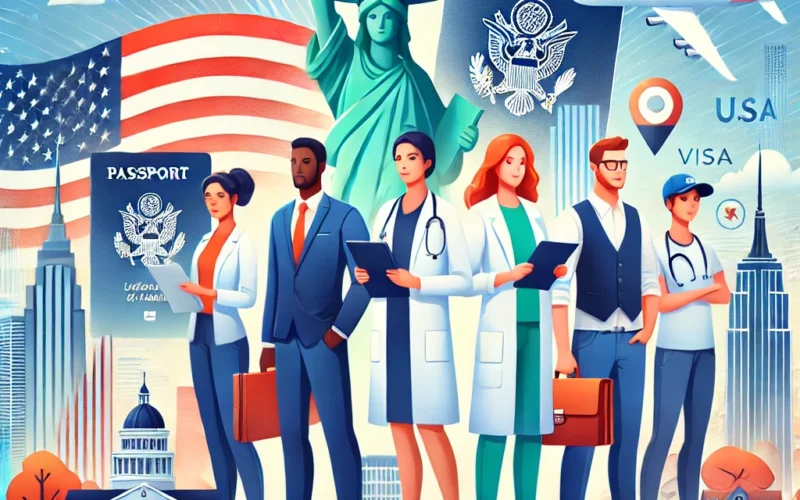The United States is a hub of career opportunities, attracting professionals from across the globe. With its thriving industries and competitive salaries, the U.S. offers a chance for individuals to work on cutting-edge projects and grow professionally.
However, for non-citizens, the primary challenge lies in securing the necessary legal authorization to work. Visa-sponsored jobs offer a pathway to achieving this goal.
In this guide, we’ll explore the ins and outs of visa sponsorship and how to successfully land a job in the U.S. as an international professional.
What Are Visa Sponsored Jobs?
Visa-sponsored jobs are positions where an employer in the United States agrees to facilitate a foreign worker’s visa application.
This sponsorship involves the employer taking responsibility for the necessary documentation, covering costs, and proving to immigration authorities that hiring international talent is essential for the role.
These opportunities are vital for foreign professionals as they provide legal work authorization and access to industries that actively seek global talent, such as technology, healthcare, engineering, and education.
Common Visa Categories for Sponsored Employment
1. H-1B Visa
The H-1B visa is one of the most widely used work visas in the United States. It is intended for individuals in specialized fields such as technology, engineering, healthcare, and finance.
To qualify, the employer must prove that the position requires specific expertise and that the applicant meets the qualifications.
2. L-1 Visa
Designed for intracompany transfers, the L-1 visa allows multinational companies to relocate employees from their foreign offices to U.S.-based operations. It is commonly used for managerial or specialized roles.
3. O-1 Visa
This visa is specifically for individuals with extraordinary abilities in fields like arts, sciences, education, or athletics.
To secure an O-1 visa, candidates must provide evidence of their exceptional achievements, such as awards or notable contributions.
4. EB-2 and EB-3 Visas
The EB-2 and EB-3 visas are employment-based options for professionals with advanced degrees or exceptional abilities. These visas also provide a pathway to permanent residency in the U.S.
5. TN Visa
Under the USMCA (United States-Mexico-Canada Agreement), Canadian and Mexican citizens can apply for a TN visa, which is specific to certain professions, including engineering, teaching, and healthcare.
Industries That Regularly Offer Visa Sponsorship
1. Technology
The tech industry is a leader in sponsoring visas, given its demand for skilled professionals. Companies like Google, Amazon, and Microsoft often hire international talent for roles in software development, cybersecurity, and artificial intelligence.
2. Healthcare
Healthcare institutions in the U.S. face a growing need for qualified workers. Hospitals and clinics frequently sponsor visas for doctors, nurses, medical researchers, and other specialized healthcare professionals.
3. Engineering
Engineering roles, especially in aerospace, mechanical, and civil engineering, attract global talent. Many U.S.-based firms sponsor visas to meet workforce needs.
4. Academia and Research
Universities and research organizations are known to hire international professors, postdoctoral researchers, and graduate assistants for niche fields or advanced academic roles.
How to Qualify for a Visa Sponsored Job
1. Educational Credentials
Most visa-sponsored jobs require a relevant degree or certification. For advanced positions, having a master’s degree or higher can significantly improve your chances.
2. Relevant Experience
Work experience plays a key role in your application. Employers value proven expertise, particularly in fields with a high demand for specialized skills.
3. Employer Sponsorship
Employers in the U.S. must prove that hiring a foreign worker is necessary and that no suitable local candidates are available. This often requires the employer to go through a formal certification process.
How to Find Visa Sponsored Jobs in the USA
1. Leverage Online Job Boards
Platforms like LinkedIn, Glassdoor, and Indeed allow job seekers to filter listings by companies offering visa sponsorship. Regularly checking these platforms can help you stay updated on opportunities.
2. Build Professional Connections
Networking is an essential part of the job search. Attend industry events, engage with professionals on LinkedIn, and join relevant forums or groups to expand your reach.
3. Consult Recruitment Agencies
Agencies specializing in international placements can connect you with companies actively seeking foreign talent. These agencies also assist in navigating the visa application process.
Steps to Apply for a Visa Sponsored Job
1. Prepare a Strong Resume
Your resume should emphasize your qualifications, skills, and achievements relevant to the role. Tailor it to match the specific requirements of the job and include a note about your readiness for sponsorship.
2. Write a Personalized Cover Letter
A compelling cover letter allows you to explain your qualifications in detail. Highlight how your expertise aligns with the employer’s needs and mention your visa sponsorship requirements upfront.
3. Master the Interview Process
Be ready to address questions about your skills, experience, and understanding of the visa process during interviews. Confidence and thorough preparation can help you stand out.
Challenges of Visa Sponsored Jobs
1. Visa Limitations
Work visas are often tied to specific employers, making it challenging to switch jobs without restarting the sponsorship process.
2. Processing Delays
Visa applications can take months to process, requiring careful planning and patience.
3. Adapting to U.S. Work Culture
Adjusting to new workplace norms and cultural expectations can be overwhelming for some international workers. Proactively learning about U.S. workplace etiquette can ease the transition.
Tips for Success in Securing a Visa Sponsored Job
- Focus on High-Demand Industries: Research sectors like technology, healthcare, and engineering for roles that commonly require international talent.
- Stay Updated on Immigration Policies: Familiarize yourself with changes to visa regulations and application timelines.
- Highlight Unique Skills: Employers are more likely to sponsor candidates who bring specialized expertise.
- Leverage Networking Opportunities: Building relationships within your industry can lead to job referrals and insider knowledge about open positions.
- Be Persistent: The process can be competitive, but consistent effort and determination often lead to success.
Future Prospects for Visa Sponsored Jobs
As industries like technology and healthcare continue to evolve, the demand for skilled professionals is expected to grow.
Policy changes may also influence visa availability and sponsorship requirements. Staying informed about emerging trends will help you adapt and seize opportunities.
People also read:
Highly Rewarding Unskilled Worker Jobs in Australia with Visa Sponsorship
Visa-sponsored jobs provide a gateway for international professionals to work legally in the United States.
These roles allow individuals to contribute to thriving industries while achieving personal and professional growth.
By understanding visa options, targeting high-demand sectors, and preparing a strong application, you can turn your dream of working in the U.S. into reality. With persistence and the right strategy, you can unlock a world of opportunities.
FAQs
1. What is the most common work visa in the U.S.?
The H-1B visa is the most popular, especially for roles in technology, healthcare, and engineering.
2. Can startups sponsor work visas?
Yes, startups can sponsor visas if they meet the legal requirements and prove the necessity of hiring international talent.
3. How long does it take to process a visa?
The timeline varies but typically ranges from a few months to over a year, depending on the visa type and employer’s preparation.
4. Do I need a job offer to apply for a visa?
Yes, most employment-based visas require a confirmed job offer from a U.S. employer.
5. Are visa-sponsored jobs permanent?
Some work visas, like the EB-2 or EB-3, can lead to permanent residency, while others, such as the H-1B, are temporary but renewable.






